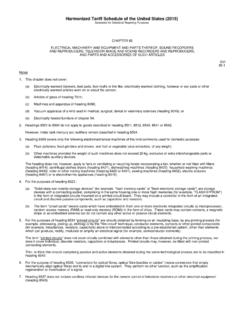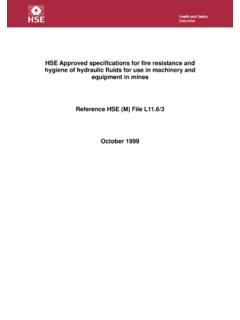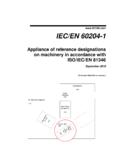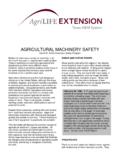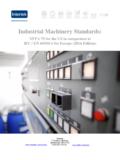Transcription of Guide to application of the Machinery Directive 2006/42/EC
1 EUROPEAN COMMISSION. Directorate-General for Internal Market, Industry, Entrepreneurship and SMEs Industrial Transformation and Advanced Value Chains Advanced Engineering and Manufacturing Systems Guide to application of the Machinery Directive 2006/42/EC . Edition July 2017. (Update of 2nd Edition). 1. Introduction to the Edition July 2017 (Update of the 2nd Edition). Directive 2006/42/EC is a revised version of the Machinery Directive , the first version of which was adopted in 1989. The new Machinery Directive has been applicable since 29th December 2009. The Directive has the dual aim of harmonising the health and safety requirements applicable to Machinery on the basis of a high level of protection of health and safety, while ensuring the free circulation of Machinery on the EU market. The revised Machinery Directive does not introduce radical changes compared with the previous versions.
2 It clarifies and consolidates the provisions of the Directive with the aim of improving its practical application . While the revised Machinery Directive was being discussed by the Council and the European Parliament, the Commission agreed to prepare a new Guide to its application . The purpose of the Guide is to provide explanations of the concepts and requirements of Directive 2006/42/EC in order to ensure uniform interpretation and application throughout the EU. The Guide also provides information about other related EU. legislation. It is addressed to all of the parties involved in applying the Machinery Directive , including Machinery manufacturers, importers and distributors, Notified Bodies, standardisers, occupational health and safety and consumer protection agencies and officials of the relevant national administrations and market surveillance authorities.
3 It may also be of interest to lawyers and to students of EU law in the fields of the internal market, occupational health and safety and consumer protection. It should be stressed that only the Machinery Directive and the texts implementing its provisions into national law are legally binding. The 2nd Edition of the Guide was endorsed by the Machinery Committee on 2. June 2010. In comparison with the 1st Edition, it was completed with comments on Annexes III to XI of the Machinery Directive . Some errors noticed by readers have been corrected. Legal references and terms have been updated in line with the Lisbon Treaty - in particular, where the Directive refers to 'the Community', the Guide now refers to 'the EU'. Following discussion with the industry, the comments relating to chains, ropes and webbing for lifting purposes in 44, 330, 340, 341, and 357 have been revised in order to clarify the practical application of the requirements relating to these products.
4 The 2nd Edition also includes a thematic index to facilitate consultation of the Guide . The numbering of the sections of the Guide is unchanged. The Guide takes account of the amendment to Directive 2006/42/EC introduced by Regulation (EC) No 569/2009 relating to the regulatory procedure with scrutiny for the Machinery Committee. It also takes account of the provisions of Regulation (EC) No 765/2008 relating to market surveillance, which apply in a complementary way. 2. This Update to the 2nd Edition of the Guide , further named Edition , has been completed to include the amendments made to the Machinery Directive by the Directive 2009/127/EC on Pesticide equipment and the Regulation (EU) No 167/2013 on the approval and market surveillance of agricultural and forestry vehicles (Tractors). In addition, guidance on partly completed Machinery and assemblies has been added, as well as inserting clarifications and corrections to the concepts of "safety components'', "new and used Machinery ", "marking of Machinery ".
5 A number of key guidance decisions of the Machinery Working Group have been incorporated into this text. The Guide is published on the Commission's Website EUROPA1 in English. This updated Edition is intended to be a living document, edited and updated with new guidance once approved by the Machinery Working Group. It will be made available in other EU languages, but only the English version will be checked by the Commission. Therefore, in case of doubt, the English version should be taken as the reference. The Guide can be downloaded and is presented in a printable format. The text of the Directive is presented in boxed red italic type - the comments follow in black type. The Guide has been prepared with the help of an Editorial Group2 and this Update of the 2nd Edition has been carried out by an external consultant3 and the Commission, assisted by some of the members of the Editorial Group.
6 The Commission4 wishes to warmly thank the members of the Editorial Group both for the huge amount of work they have carried out as well as for the efficient, constructive and cooperative spirit in which the drafts have been prepared. In parallel to the work of the Editorial Group, a Machinery Core Group established by Orgalime, including representatives of the main sectors of Machinery manufacturing, has provided invaluable input from the industry. The drafts prepared by the Editorial Group have been submitted to the Member States and stakeholders for comments. The Commission would also like to thank all those who have made comments. We have tried to take them into account as far as possible. 1. 2 The following people have taken part in the work of the Editorial Group: Lennart Ahnstr m, Emilio Borzelli, Robert Chudzik, Roberto Cianotti, John Colreavy, Mike Dodds, Cosette Dussaugey, Marcel Dutrieux, Pascal Etienne, Ludwig Finkeldei, Gun Fridfelt, Mikael Holst, Tuiri Kerttula, Andreas K hn, Thomas Kraus, Patrick Kurtz, Kevin Lane, Leila Martin, Wolfgang Lentsch, G ran Lundmark, Thomas Moessner, Anders Mortensen, Phil Papard, Boguslaw Piasecki, Marc Schulze, Katri Tytykoski, Roger Upfold, Wendy Van Aerschot, Gustaaf Vandegaer, Henk van Eeden, Richard Wilson, J rg Zwicky.
7 3 Phil Papard Consulting. 4 The Commission representatives: Ian Fraser (until 2013), Felicia Stoica, Mario Gabrielli Cossellu. 3. Of course, the Commission takes full responsibility for the content of the Guide . Readers are invited to communicate any corrections or comments5 so that they can be taken into account in preparing future updates or a revised 3rd Edition. Brussels, July 2017. 5 Corrections, comments and suggestions for improvement should be addressed to the functional e-mail box: 4. Table of contents The Citations 1 The citations 2 The legal basis of the Machinery Directive The Recitals 3 The recitals Recital 1 4 The History of the Machinery Directive Recital 2 5 The economic and social importance of the Machinery Directive Recital 3 6 Health and safety Recital 4 7 Definitions Recital 5 8 Inclusion of construction site hoists Recital 6 9 Inclusion of portable cartridge-operated fixing and other impact Machinery Recital 7 10 equipment intended for lifting persons with Machinery designed for lifting goods Recital 8 11 Agricultural and forestry tractors Recitals 9 & 10 12 Market surveillance Recital 11 13 Formal objection to standards and the safeguard clause Recital 12 14 Regulations on use of Machinery Recital 13 15 Measures to deal with groups of hazardous Machinery presenting the
8 Same risks Recital 14 16 The state of the art Recital 15 17 Machinery for consumer use Recital 16 18 Partly completed Machinery Recital 17 19 Trade fairs and exhibitions Recital 18 20 The New Approach and the New Legislative Framework Recital 19 21 Conformity assessment Recital 20 22 Annex IV Machinery Recitals 21 & 22 23 The CE-marking Recital 23 24 Risk assessment Recital 24 25 The technical construction file Recital 25 26 Legal remedies Recital 26 27 Enforcement Recital 27 28 Amendment of the Lifts Directive Recital 28 29 Subsidiarity and proportionality Recital 29 30 National correlation tables Recital 30 31 The Machinery Committee The Articles Article 1 (1) 32 The products covered by the Machinery Directive Article 2 33 The use of the term ' Machinery ' in the broad sense Article 1 (a) 34 Machinery in the strict sense Articles 1 (a) & 2 (a) 35 The basic definition st 1 indent nd 2 indent 36 Machinery supplied without connection components rd 3 indent 37 Machinery to be installed on a specific support th 4 indent 38 Assemblies of Machinery 39 Assemblies comprising new and existing Machinery th 5 indent 40 Manually powered Machinery for lifting loads Articles 1 (b) & 2 (b) 41 Interchangeable equipment Articles 1 (c) & 2 (c) 42 Safety components 5.
9 Articles 1 (d) & 2 (d) 43 Lifting accessories Articles 1 (e) & 2 (e) 44 Chains, ropes and webbing Articles 1 (f) & 2 (f) 45 Removable mechanical transmission devices Articles 1 (g) & 2 (g) 46 Partly completed Machinery Article 1 (2) 47 Products excluded from the scope of the Machinery Directive Article 1 (2) (a) 48 Safety components intended to be used as spare parts to replace identical components and supplied by the manufacturer of the original Machinery Article 1 (2) (b) 49 equipment for use in fairgrounds and/or amusement parks Article 1 (2) (c) 50 Machinery for nuclear purposes Article 1 (2) (d) 51 Weapons, including firearms Article 1 (2) (e) 52 Means of transport st 1 indent 53 Agricultural and forestry tractors nd 2 indent 54 Four-or-more-wheeled road vehicles and their trailers rd 3 indent 55 Two- and three-wheeled road vehicles th 4 indent 56 Motor vehicles intended for competition th 5 indent 57 Means of transport by air, on water and on rail networks Article 1 (2) (f) 58 Seagoing vessels and mobile offshore units and Machinery installed on board such vessels and/or units Article 1 (2) (g) 59 Machinery for military or police purposes Article 1 (2) (h) 60 Machinery for research purposes Article 1 (2) (i) 61 Mine winding gear Article 1 (2) (j) 62 Machinery intended to move performers during artistic performances Article 1 (2) (k)
10 63 Machinery covered by the Low Voltage Directive st 1 indent 64 Household appliances intended for domestic use nd 2 indent 65 Audio and video equipment rd 3 indent 66 Information technology equipment th 4 indent 67 Ordinary office Machinery th 5 indent 68 Low-voltage switchgear and control gear th 6 indent 69 Electric motors Article 1 (2) (l) 70 High-voltage electrical equipment Article 2 (h) 71 The definition of placing on the market'. 72 New and used Machinery 73 The stage at which the Machinery Directive applies 74 The legal and contractual forms of placing on the market 75 Auctions 76 Placing on the market of assemblies of Machinery 77 Placing on the market of partly completed Machinery Article 2 (i) 78 The definition of manufacturer'. 79 Who is the manufacturer? 80 A person manufacturing Machinery for his own use 81 Other persons who may be considered as manufacturers 82 Machinery modified before it is first put into service 83 Distributors Article 2 (j) 84 The possibility to appoint an authorised representative 85 The tasks of an authorised representative Article 2 (k) 86 The definition of putting into service'.
